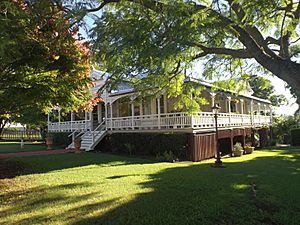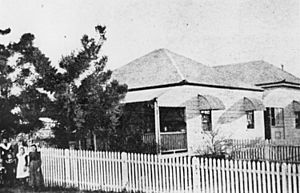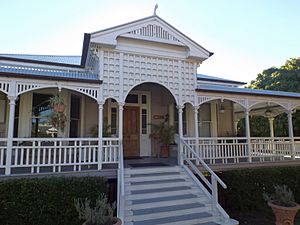Wiss House facts for kids
Quick facts for kids Wiss House |
|
|---|---|

House and gardens, 2015
|
|
| Location | 7 Ann Street, Kalbar, Queensland, Australia |
| Design period | 1900 - 1914 (early 20th century) |
| Built | c. 1912 - 1940s |
| Official name: Wiss House (former) | |
| Type | state heritage (landscape, built) |
| Designated | 26 August 1993 |
| Reference no. | 601137 |
| Significant period | 1910s, 1940s (fabric) 1910s-1970s (historical, social) |
| Significant components | air raid shelter, trees/plantings, residential accommodation - main house, service wing |
| Lua error in Module:Location_map at line 420: attempt to index field 'wikibase' (a nil value). | |
Wiss House is a special old house located at 7 Ann Street in Kalbar, Queensland, Australia. It was built around 1912 and is known for its interesting history and design. Today, it is protected as a heritage site on the Queensland Heritage Register. This means it's an important part of Queensland's past.
Contents
The Story of Wiss House
Wiss House was built for Lionel Ainger Wiss and his family. They bought the land in 1912, and soon after, their new home was constructed.
The Wiss Family Arrives
Lionel Wiss and his brothers, Campbell and Alfred, came to Queensland from Germany around 1887. After a short time, Alfred went back to England. Lionel and Campbell moved to Ipswich and worked in a grocery store for about three years.
Starting a Business in Engelsburg
In 1890, the brothers bought land in a town called Engelsburg. This area, south of Ipswich, was settled by German farmers in the 1870s. Engelsburg was a small but growing town with shops, churches, and a school.
Lionel and Campbell built a small store and a house next to it. In August 1890, plans for their store were being made. By September, the store for Lionel Wiss was being built.
Wiss Bros Store and Community Life
Lionel Wiss married Maria Elise Wiuff in 1890. He and Campbell started their business, Wiss Bros, in Engelsburg. Their store was one of the first businesses in the town. It became very important as the area grew with dairy farms and agriculture.
Campbell Wiss left the partnership around 1904, but the store kept the name Wiss Bros. The business did very well, and a new store was built in 1909. Lionel Wiss was a respected person in the community. He was involved in local events and his church.
In 1910, Lionel Wiss bought a large piece of land in Engelsburg. He divided about half of it into smaller blocks for houses in 1916. This helped create the western part of the town. In 1916, Engelsburg was renamed Kalbar when the railway arrived.
Building the Family Home
Even though Lionel Wiss owned land on the west side of town, he chose a special spot for his family's new, bigger house. He picked four blocks of land on a small hill overlooking the town. This was a great location, and Wiss House was one of the first homes built on that hill.
Lionel Wiss passed away in 1932. His wife, Maria Elise, lived in the house until 1957. Their daughters, Adeline and Phyllis, stayed there until the mid-1970s. Adeline also ran the Wiss Bros store until it was sold in 1947.
During World War II, an underground air-raid shelter was built in the backyard. It's not clear if parts of it are still there today.
What Wiss House Looks Like
Wiss House is a large timber house with a special design. It has a corrugated iron roof that slopes down, with two pointed sections called gables. The house has verandahs (porches) on three sides. A kitchen area extends from the back. The house stands on timber stumps with wooden panels underneath.
Decorative Features
The house has many beautiful wooden decorations. These include brackets under the roof, fancy boards on the gables, and decorative arches on the verandahs. The verandah posts are tall and narrow at the bottom, getting wider at the top.
The main entrance has three arches with a large patterned panel. This panel has a pressed metal sheet behind it, and the arches have a rope-like pattern on their edges.
Inside the House
The front of the house is balanced, with a central entrance and windows on either side. The north side has a large bay window under a projecting gable. Some verandahs near the kitchen have been closed in.
Inside, the walls are made of single VJ pine boards. VJ stands for "V-joint," which is a way the boards fit together. The house has cedar wood details and ceilings made of pressed metal or wooden boards. Some rooms, like the hallway, have unpainted pine walls.
The house has a central hallway. There are four bedrooms at the front. The drawing room and dining room are towards the back. The drawing room on the north side was designed to have a great view of the town. It has a large bay window that sticks out, which is also seen as a gable on the roof.
The Grounds
Outside, the property has a fenced concrete swimming pool. There are also mature trees along the northern edge of the property.
Why Wiss House is Important
Wiss House is listed on the Queensland Heritage Register because it meets several important criteria.
Showing Queensland's History
Wiss House helps us understand how Queensland's history unfolded. It shows how the town of Engelsburg (now Kalbar) grew in the 1910s. It also shows the economic growth of both the town and the Fassifern area during that time.
A Great Example of Old Homes
The house is a good example of a large, well-preserved home from the late Federation era. This was a time when Australia was forming as a nation. It shows the typical features and details of a grand house built in a small country town.
Beautiful Design and Look
Wiss House is important because of its beauty. People in the local community value its location and how it looks within the town of Kalbar. The quality of its timber work and pressed metal details are admired. The inside layout is also well-designed, especially how the main room offers a view of the town.
Special Connection to the Community
Wiss House has a strong connection to the Kalbar community. It helps define the town's identity because of its physical presence and location. It was also the home of Lionel Ainger Wiss, who was a very important person in Kalbar in the late 1800s and early 1900s.
Linked to Important People
The house has a special link to Lionel Ainger Wiss and his family. They played a big part in the business, social life, and physical development of Kalbar and the surrounding area from the 1890s to the 1940s.
Images for kids






